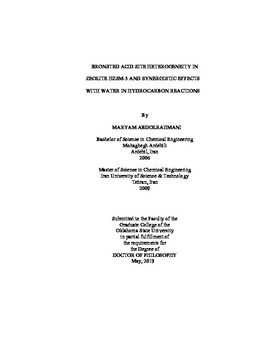| dc.description.abstract | Zeolite catalysts are solid Bronsted acids whose reactivity is typically associated with the number of protons at crystalline framework bridging acid sites (BAS's) and the bonding environments around them. Direct observation of multiple reactive sites in the zeolite HZSM-5, a member of the MFI family of zeolite structures, contradicts the traditional view of only one type of active protonic species in the zeolite HZSM-5. For the first time, an acidic and reactive species has been directly observed in HZSM-5 contributed to a small population of highly deshielded acid sites arising from extra-framework (EFAl) moieties in the solid-state 1H MAS NMR spectrum at 12-15 ppm. Post-synthetic treatments of HZSM-5 zeolite modify the concentration of acidic protons arising from framework (FAl) and EFAl moieties. In this work, the removal and re-creation of EFAl species in the vicinity of BAS, via chemical washing using ammonium hexafluorosilicate (AHFS) and steaming, respectively, were quantified by 1H spin-counting NMR experiments on HZSM-5 with Si/Al ratio of 11.5, 15, and 40. Spin-counting data revealed that FAl protons only comprise ca. 50% of the total protons in ZSM-5 at Si/Al = 15 and the remaining 50 % is assigned to EFAl protons. Probe-molecule reactions between benzene-d6 and HZSM-5 at Si/Al = 15 (control, washed, mild steamed, and severe steamed) carried out at low pressure and room temperature, showed that adding sub-stoichiometric amounts of water enhanced H/D exchange reaction rates in the HZSM-5 zeolites with H-EFAL species. Our data showed that the synergistic effect between EFAl and water most likely occurs due to an increase in the "vehicle hopping" proton-transfer mechanism. In control and steamed samples, maximum reaction rates were observed at water loadings of ca. 0.1 equivalents, as a result of simultaneous presence of FAl and EFAl species. On the other hand, for the washed sample with single type of acid site, framework BAS, adding water suppressed the rate of reaction. Thus, the most active catalysts in room-temperature probe reactions contain all three types of potentially reactive protons, i.e., protons from BAS's and protons from EFAl species, and protons from trace amounts of water. | |
